Abdelhamid Salem
Fundamental Limits of Localization with Fluid Antenna Systems: A Fisher Information Analysis
Dec 15, 2025Abstract:In this letter, we investigate the fundamental limits of localization in fluid antenna systems (FAS) utilizing a Fisher-information-theoretic framework. We develop a unified model to quantify the localization information extractable from time-of-arrival (ToA) and angle-of-arrival (AoA) measurements, explicitly capturing the synthetic aperture effects induced by FAS. Closed-form expressions are derived for the equivalent Fisher information matrix (EFIM) and the corresponding positioning error bound (PEB) in both user-side and base-station (BS)-side FAS configurations. Also, we propose optimal port-selection strategies based on greedy algorithms and convex relaxation to maximize the information gain under a constrained number of activated ports. Numerical results demonstrate that the proposed port-selection schemes can substantially tighten the PEB compared with random activation, thereby confirming the strong potential of FAS to enable high-precision localization. These results offer analytical insights and practical design guidelines for FAS-aided positioning in future-generation wireless networks
Secure ISAC with Fluid Antenna Systems: Joint Precoding and Port Selection
Sep 30, 2025Abstract:This paper presents a novel framework for enhancing physical-layer security in integrated sensing and communication (ISAC) systems by leveraging the reconfigurability of fluid antenna systems (FAS). We propose a joint precoding and port selection (JPPS) strategy that maximizes the sum secrecy rate while simultaneously ensuring reliable radar sensing. The problem is formulated using fractional programming (FP) and solved through an iterative algorithm that integrates FP transformations with successive convex approximation (SCA). To reduce computational complexity, we further develop low-complexity schemes based on zero-forcing (ZF) precoding, combined with greedy port selection and trace-inverse minimization. Simulation results demonstrate substantial improvements in both secrecy performance and sensing accuracy compared to conventional baselines, across a wide range of FAS ports, user loads, and sensing targets. These findings highlight the critical importance of FAS geometry optimization in enabling secure and efficient joint communication-sensing for next-generation wireless networks.
Secure Communication of UAV-mounted STAR-RIS under Phase Shift Errors
Jul 08, 2025Abstract:This paper investigates the secure communication capabilities of a non-orthogonal multiple access (NOMA) network supported by a STAR-RIS (simultaneously transmitting and reflecting reconfigurable intelligent surface) deployed on an unmanned aerial vehicle (UAV), in the presence of passive eavesdroppers. The STAR-RIS facilitates concurrent signal reflection and transmission, allowing multiple legitimate users-grouped via NOMA-to be served efficiently, thereby improving spectral utilization. Each user contends with an associated eavesdropper, creating a stringent security scenario. Under Nakagami fading conditions and accounting for phase shift inaccuracies in the STAR-RIS, closed-form expressions for the ergodic secrecy rates of users in both transmission and reflection paths are derived. An optimization framework is then developed to jointly adjust the UAV's positioning and the STAR-RIS power splitting coefficient, aiming to maximize the system's secrecy rate. The proposed approach enhances secure transmission in STAR-RIS-NOMA configurations under realistic hardware constraints and offers valuable guidance for the design of future 6G wireless networks.
A First Look at the Performance Enhancement Potential of Fluid Reconfigurable Intelligent Surface
Feb 24, 2025Abstract:The fluid antenna concept represents shape-flexible and position-flexible antenna technologies designed to enhance wireless communication applications. In this paper, we apply this concept to reconfigurable intelligent surfaces (RISs), introducing fluid RIS (FRIS), where each tunably reflecting element becomes a fluid element with additional position reconfigurability. This new paradigm is referred to as fluid RIS (FRIS). We investigate an FRIS-programmable wireless channel, where the fluid meta-surface is divided into non-overlapping subareas, each acting as a fluid element that can dynamically adjust both its position and phase shift of the reflected signal. We first analyze the single-user, single-input single-output (SU-SISO) channel, in which a single-antenna transmitter communicates with a single-antenna receiver via an FRIS. The achievable rate is maximized by optimizing the fluid elements using a particle swarm optimization (PSO)- based approach. Next, we extend our analysis to the multi-user, multiple-input single-output (MU-MISO) case, where a multi-antenna base station (BS) transmits individual data streams to multiple single-antenna users via an FRIS. In this case, the joint optimization of the positions and phase shifts of the FRIS element, as well as the BS precoding to maximize the sum-rate is studied. To solve the problem, a combination of techniques including PSO, semi-definite relaxation (SDR), and minimum mean square error (MMSE) is proposed. Numerical results demonstrate that the proposed FRIS approach significantly outperforms conventional RIS configurations in terms of achievable rate performance.
Modeling and Design of RIS-Assisted Multi-cell Multi-band Networks with RSMA
Aug 04, 2024



Abstract:Reconfigurable intelligent surface (RIS) has been identified as a promising technology for future wireless communication systems due to its ability to manipulate the propagation environment intelligently. RIS is a frequency-selective device, thus it can only effectively manipulate the propagation of signals within a specific frequency band. This frequency selective characteristic can make deploying RIS in wireless cellular networks more challenging, as adjacent base stations (BSs) operate on different frequency bands. In addition, rate-splitting multiple access (RSMA) scheme has been shown to enhance the performance of RIS-aided multi-user communication systems. Accordingly, this work considers a more practical reflection model for RIS-aided RSMA communication systems, which accounts for the responses of signals across different frequency bands. To that end, new analytical expressions for the ergodic sum-rate are derived using the moment generating function (MGF) and Jensen inequality. Based on these analytical sum-rate expressions, novel practical RIS reflection designs and power allocation strategies for the RSMA scheme are proposed and investigated to maximize the achievable sum-rate in RIS-assisted multi-cell, multi-band cellular networks. Simple sub-optimal designs are also introduced and discussed. The results validate the significant gains of our proposed reflection design algorithms with RSMA over conventional schemes in terms of achievable sum-rate. Additionally, the power allocation strategy for the RSMA scheme is shown to offer superior performance compared to conventional precoding schemes that do not rely on RSMA.
User Clustering for STAR-RIS Assisted Full-Duplex NOMA Communication Systems
Dec 31, 2023Abstract:In contrast to conventional reconfigurable intelligent surface (RIS), simultaneous transmitting and reflecting reconfigurable intelligent surface (STAR-RIS) has been proposed recently to enlarge the serving area from 180o to 360o coverage. This work considers the performance of a STAR-RIS aided full-duplex (FD) non-orthogonal multiple access (NOMA) communication systems. The STAR-RIS is implemented at the cell-edge to assist the cell-edge users, while the cell-center users can communicate directly with a FD base station (BS). We first introduce new user clustering schemes for the downlink and uplink transmissions. Then, based on the proposed transmission schemes closed-form expressions of the ergodic rates in the downlink and uplink modes are derived taking into account the system impairments caused by the self interference at the FD-BS and the imperfect successive interference cancellation (SIC). Moreover, an optimization problem to maximize the total sum-rate is formulated and solved by optimizing the amplitudes and the phase-shifts of the STAR-RIS elements and allocating the transmit power efficiently. The performance of the proposed user clustering schemes and the optimal STAR-RIS design are investigated through numerical results
STAR-RIS Assisted Full-Duplex Communication Networks
Sep 26, 2023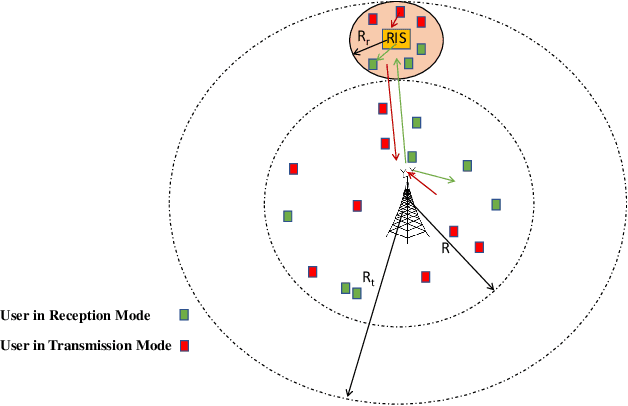
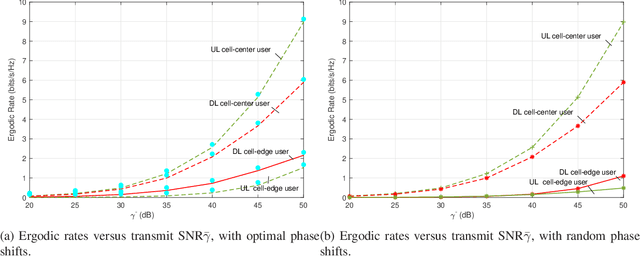
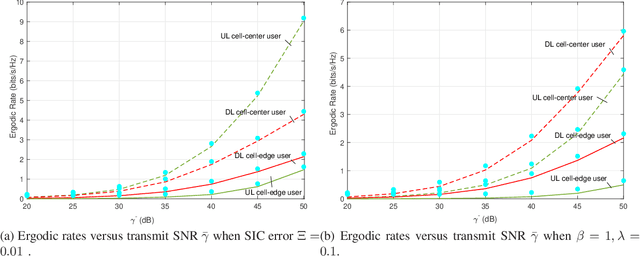
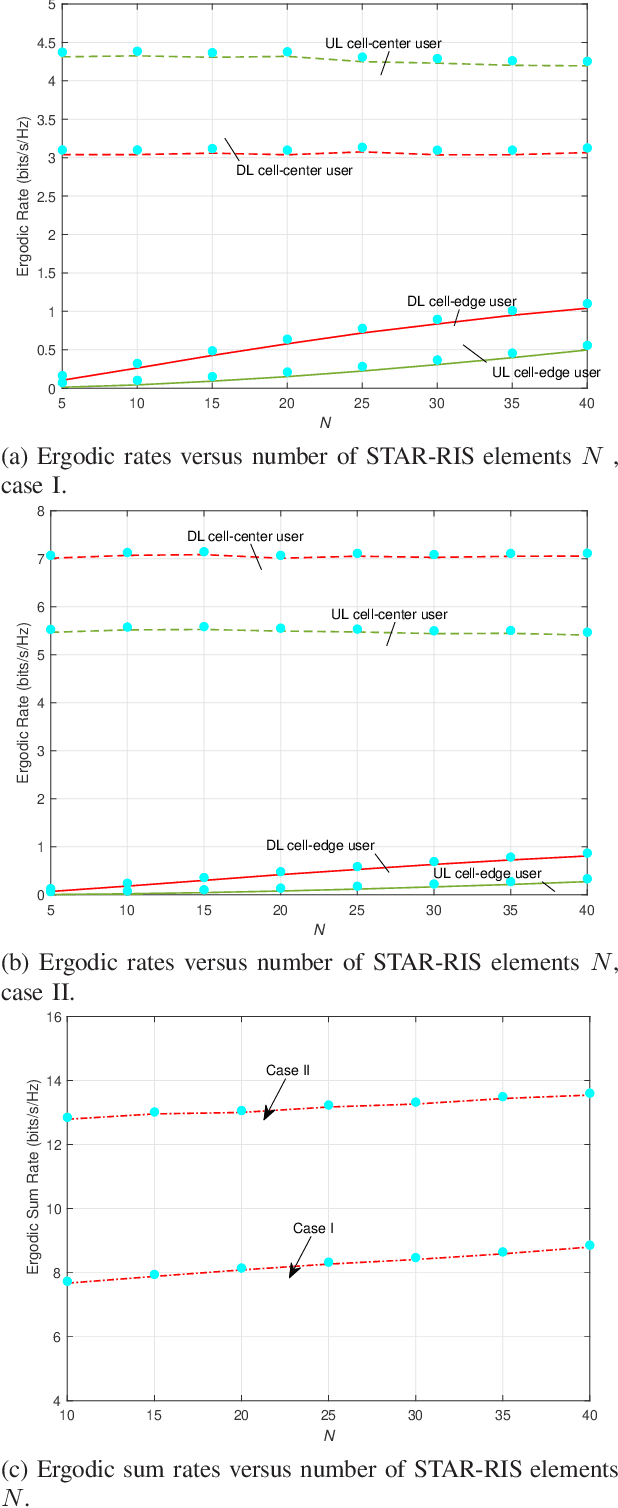
Abstract:Different from conventional reconfigurable intelligent surfaces (RIS), a recent innovation called simultaneous transmitting and reflecting reconfigurable intelligent surface (STAR-RIS) has emerged, aimed at achieving complete 360-degree coverage in communication networks. Additionally, fullduplex (FD) technology is recognized as a potent approach for enhancing spectral efficiency by enabling simultaneous transmission and reception within the same time and frequency resources. In this study, we investigate the performance of a STAR-RIS-assisted FD communication system. The STAR-RIS is strategically placed at the cell-edge to facilitate communication for users located in this challenging region, while cell-center users can communicate directly with the FD base station (BS). We employ a non-orthogonal multiple access (NOMA) pairing scheme and account for system impairments, such as self-interference at the BS and imperfect successive interference cancellation (SIC). We derive closed-form expressions for the ergodic rates in both the up-link and down-link communications and extend our analysis to bidirectional communication between cell-center and cell-edge users. Furthermore, we formulate an optimization problem aimed at maximizing the ergodic sum-rate. This optimization involves adjusting the amplitudes and phase-shifts of the STAR-RIS elements and allocating total transmit power efficiently. To gain deeper insights into the achievable rates of STAR-RIS-aided FD systems, we explore the impact of various system parameters through numerical results.
Impact of Phase-Shift Error on the Secrecy Performance of Uplink RIS Communication Systems
Dec 31, 2022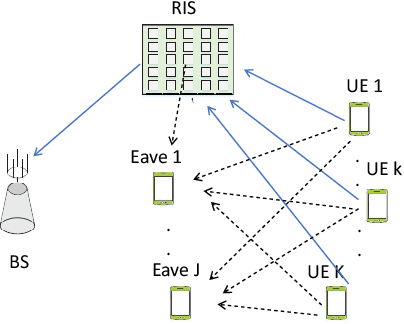
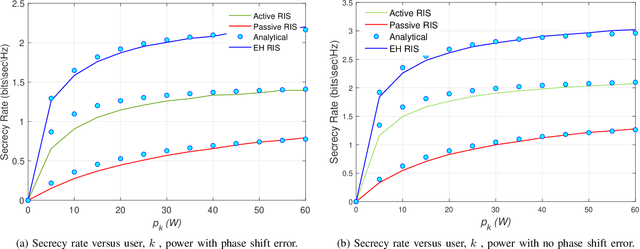
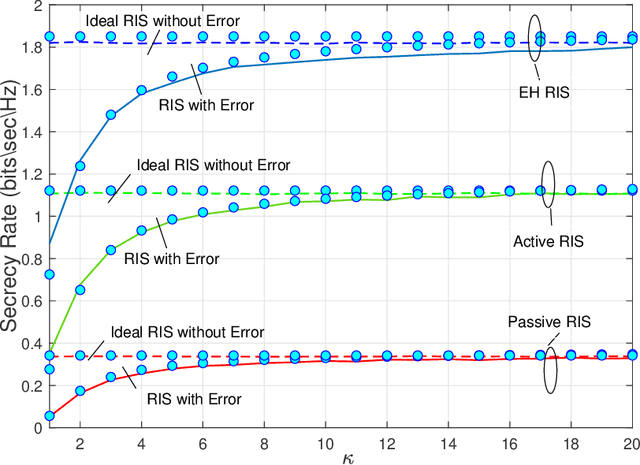
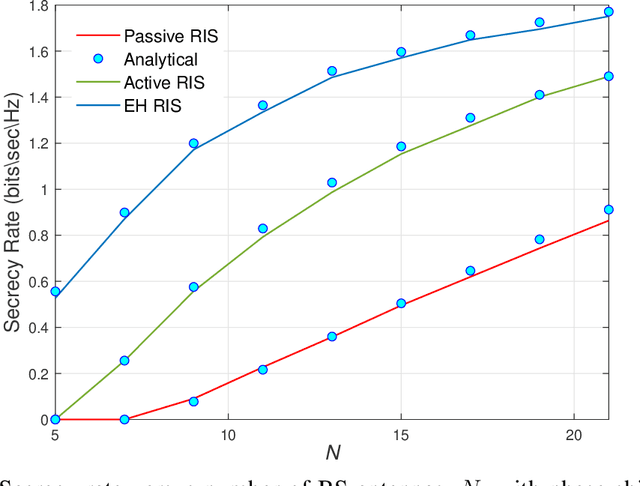
Abstract:Reconfigurable intelligent surface (RIS) has been recognized as a promising technique for the sixth generation (6G) of mobile communication networks. The key feature of RIS is to reconfigure the propagation environment via smart signal reflections. In addition, active RIS schemes have been recently proposed to overcome the deep path loss attenuation inherent in the RIS-aided communication systems. Accordingly, this paper considers the secrecy performance of up-link RIS-aided multiple users multiple-input single-output (MU-MISO) communication systems, in the presence of multiple passive eavesdroppers. In contrast to the existing works, we investigate the impact of the RIS phase shift errors on the secrecy performance. Taking into account the complex environment, where a general Rician channel model is adopted for all the communication links, closed-form approximate expressions for the ergodic secrecy rate are derived for three RIS configurations, namely, i) passive RIS, ii) active RIS, iii) active RIS with energy harvesting (EH RIS). Then, based on the derived expressions, we optimize the phase shifts at the RIS to enhance the system performance. In addition, the best RIS configuration selection is considered for a given target secrecy rate and amount of the power available at the users. Finally, Monte-Carlo simulations are provided to verify the accuracy of the analysis, and the impact of different system parameters on the secrecy performance is investigated. The results in this paper show that, an active RIS scheme can be implemented to enhance the secrecy performance of RIS-aided communication systems with phase shift errors, especially when the users have limited transmission power.
Rethinking Dense Cells for Integrated Sensing and Communications: A Stochastic Geometric View
Dec 25, 2022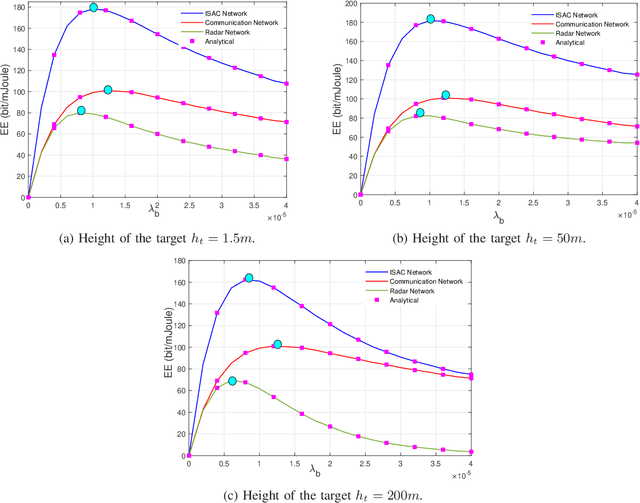
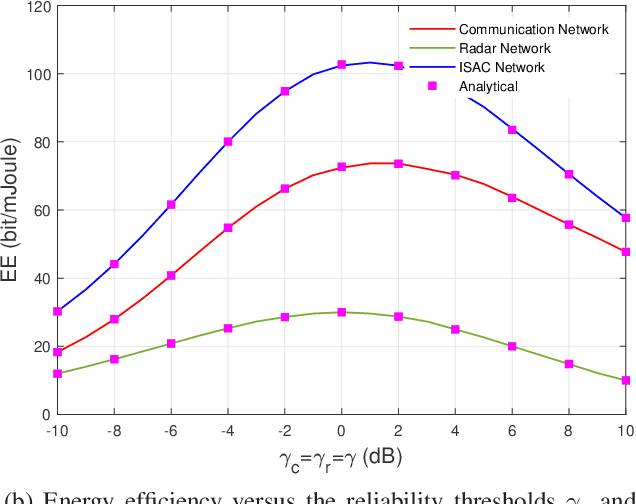
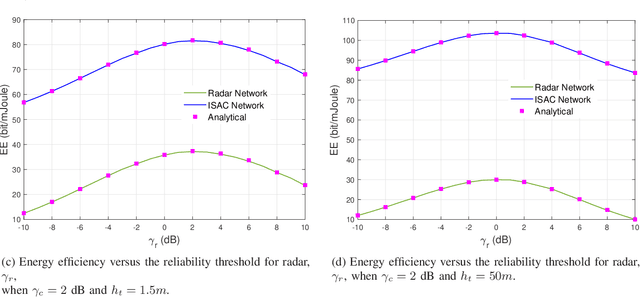
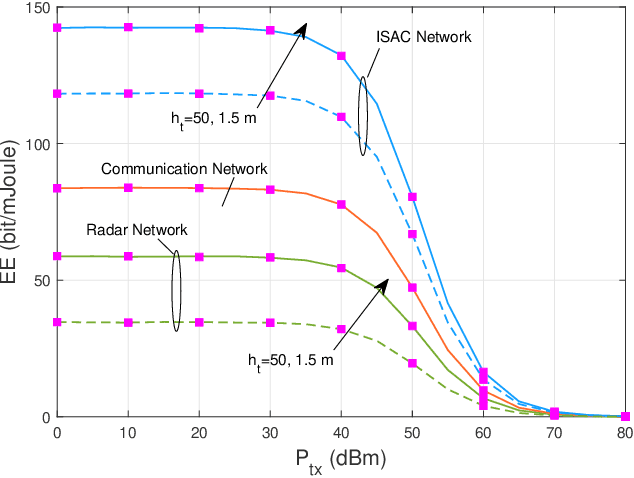
Abstract:The inclusion of the sensing functionality in the coming generations of cellular networks, necessitates a rethink of dense cell deployments. In this paper, we analyze and optimize dense cell topologies for dual-functional radar-communication (DFRC) cellular networks. With the aid of tools from stochastic geometry, we derive new analytical expressions of the potential spectral efficiencies in (bit/sec/m^{2}) of radar and communication systems. Based on the new formulations of the potential spectral efficiencies, the energy efficiency (bit/Joule) of DFRC systems is provided in a tractable closed-form formula. Then, an optimization problem to obtain the optimal base station (BS) density that maximizes the network-level energy efficiency is formulated and investigated. In this regard, the mathematical expression of the energy efficiency is shown to be a uni-modal and concave function in the density of the BSs. Therefore, optimal density of the BSs that maximizes the energy efficiency can be obtained. Our analytical and numerical results demonstrate that the inclusion of the sensing functionality clearly differentiates the optimal BS topologies for the DFRC systems against classical communication-only systems.
NOMA Made Practical: Removing the Receive SIC Processing through Interference Exploitation
Oct 15, 2022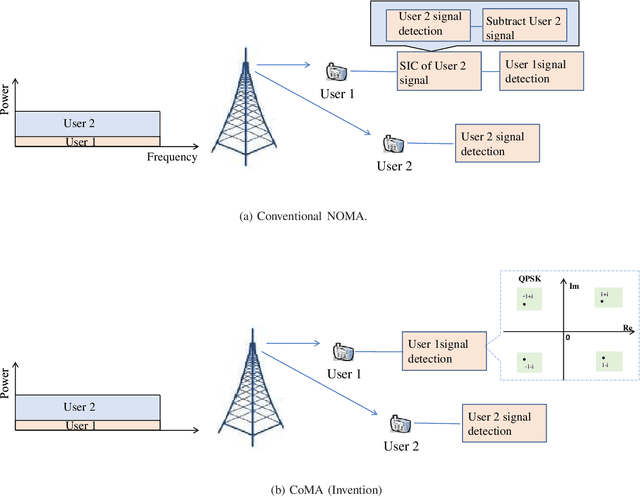
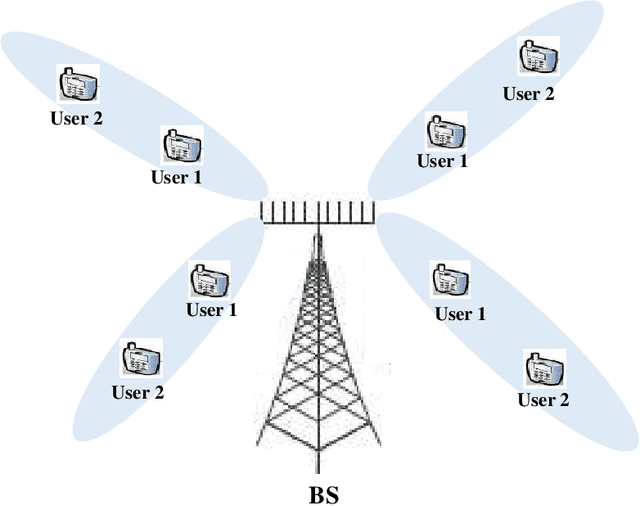
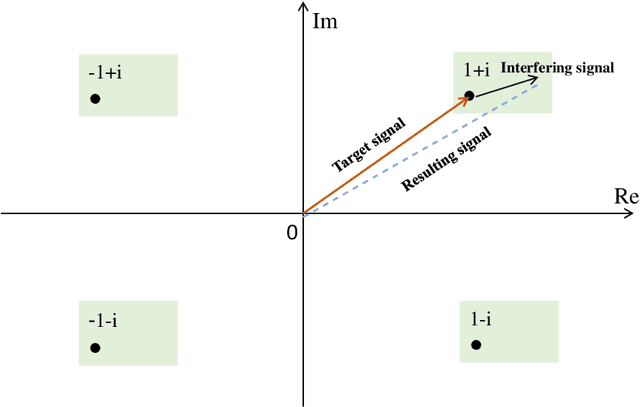
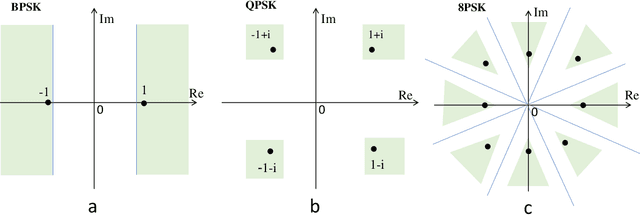
Abstract:Non-orthogonal multiple access (NOMA) is a powerful transmission technique that enhances the spectral efficiency of communication links, and is being investigated for 5G standards and beyond. A major drawback of NOMA is the need to apply successive interference cancellation (SIC) at the receiver on a symbol-by-symbol basis, which limits its practicality. To circumvent this, in this paper a novel constructive multiple access (CoMA) scheme is proposed and investigated. CoMA aligns the superimposed signals to the different users constructively to the signal of interest. Since the superimposed signal aligns with the data signal, there is no need to remove it at the receiver using SIC. Accordingly, SIC component can be removed at the receiver side. In this regard and in order to provide a comprehensive investigation and comparison, different optimization problems for user paring NOMA multiple-input-single-output (MISO) systems are considered. Firstly, an optimal precoder to minimize the total transmission power for CoMA subject to a quality-of-service constraint is obtained, and compared to conventional NOMA. Then, a precoder that minimizes the CoMA symbol error rate (SER) subject to power constraint is investigated. Further, the computational complexity of CoMA is considered and compared with conventional NOMA scheme in terms of total number of complex operations. The results in this paper prove the superiority of the proposed CoMA scheme over the conventional NOMA technique, and demonstrate that CoMA is an attractive solution for user paring NOMA MISO systems with low number of BS antennas, while circumventing the receive SIC complexity.
 Add to Chrome
Add to Chrome Add to Firefox
Add to Firefox Add to Edge
Add to Edge